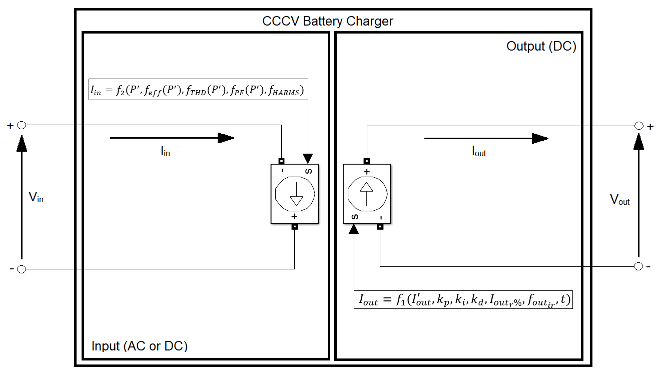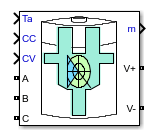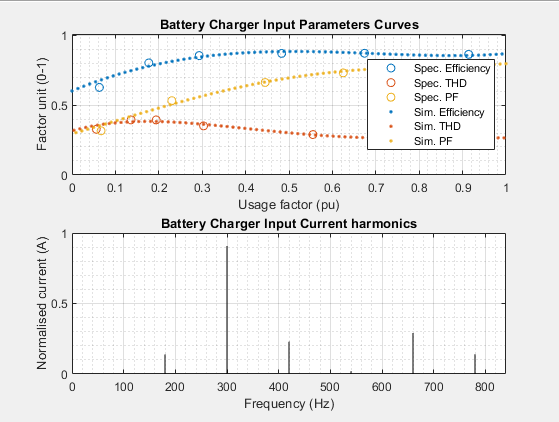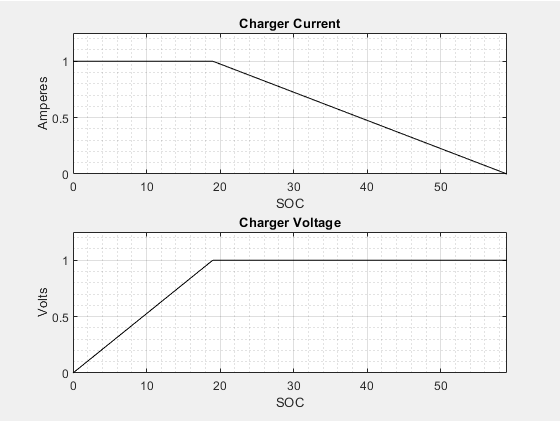CCCV Battery Charger
Constant-current constant-voltage battery charger
Description
The CCCV Battery Charger block implements a generic dynamic model battery charger. This model supports three-phase wye or delta AC, one-phase AC, or DC voltage input. The model also provides an optional ambient temperature input for charging voltage temperature compensation.
The figure shows the equivalent circuit for the CCCV Battery Charger block.

Equations
The output current of the battery charger is
Variables for the output current and related equations are:
Iout is the output current command, in A.
I'out is the pre-filtered current command, in A.
kp is the PID filter proportional gain.
ki is the PID filter integral gain.
kd is the PID filter differential gain.
Ioutr% is the current output ripple, in %.
foutir is the current output ripple frequency, in Hz.
t is the time, in s.
ξ is the dampening factor, which is limited to values between
0and0.9.⍵n is the is radian frequency, in rad/s.
d% is the overshoot, in %.
ts is the settling time, in s.
ICC is the pre-filtered current regulated current command, in A.
Ibulk is the constant current command, in A.
ICV is the pre-filtered voltage regulated current command, in A.
V'out is the voltage command, in V.
V'tc is the voltage command, in V.
Vout is the temperature compensated voltage effect, in V.
is the mean measured output voltage, in V.
Ta is the ambient temperature, in °C.
Tnom is the nominal ambient temperature, in °C.
Vtc is the voltage compensation ratio, in V/°C.
Vabs is the absorption voltage, in V.
Vfloat is the float voltage, in V.
P is the output power, in W.
is the mean measured output current, in A.
The control gains are:
The dampening factor is
When the output control is current regulated the radian frequency is
When the output control is voltage regulated the radian frequency is
The pre-filtered current command, I'out, is provided either from the pre-filtered current regulated current command, ICC, or from the pre-filtered voltage regulated current command, ICV. The graphs show the different charging cycle phases.

If the Output control mode is set to
Constant Current only (CC) or
Constant Current - Constant Voltage (CCCV) and
Vout is lower than Float voltage or Absorption
voltage, while the Absorption end
condition isn’t met
If the Output control mode is set to
Constant Current only (CC) or
Constant Current - Constant Voltage (CCCV) and
Vout is equal to the Float voltage or Absorption
voltage, while the Absorption end
condition isn’t met
When the Enable absorption phase option is selected and the battery charger switches from constant current to constant voltage control, if the Absorption end condition is not met, the ambient temperature voltage compensation, V'tc is defined as
Otherwise, the ambient temperature voltage compensation, V'tc is defined as
When the Enable absorption phase option is selected and the battery charger switches from constant current to constant voltage control, if the Absorption end condition is not met, the ambient temperature voltage compensation, V'out is defined as
Otherwise, the ambient temperature voltage compensation, V'out is defined as
The output power is defined as
The input current of the battery charger is
Variables for the input current and related equations are:
Iin is the input current command, in A.
P' is the normalized output power.
P is the output power, in W.
Pnom is the nominal output power, in W.
I'n is the normalized harmonic amplitude.
fin is the input voltage frequency, in Hz.
fn is the harmonic frequency, in Hz.
t is the time, in s.
VinA is the input voltage delayed by the fifth of its period, in V.
Vin is the input voltage of phase A delayed by the fifth of its period, in V.
Iinr% is the input current ripple, in %.
finir is the input current ripple frequency, in Hz.
θVin is the input voltage angle, in rad.
θVinA is the input voltage angle of phase A, in rad.
Where, feff, is a polynomial function following the parameters Charger efficiency and Efficiency usage factor. This polynomial order is half of the number of data pairs entered. For input values of, P', between 0 and 1, the polynomial must return values between 0 and 1. Otherwise, the polynomial order is reduced until this condition is met. If the order reaches 0, the output will remain constant for the mean value of the dataset.
Where, fTHD, is a polynomial function following the parameters Total harmonic distortion and THD usage factor. This polynomial order is half of the number of data pairs entered. For input values of, P', between 0 and 1, the polynomial must return values between 0 and 1. Otherwise, the polynomial order is reduced until this condition is met. If the order reaches 0, the output will remain constant for the mean value of the dataset.
Where, fPF, is a polynomial function following the parameters Power factor and PF usage factor. This polynomial order is half of the number of data pairs entered. For input values of, P', between 0 and 1, the polynomial must return values between 0 and 1. Otherwise, the polynomial order is reduced until this condition is met. If the order reaches 0, the output will remain constant for the mean value of the dataset.
Where, fHARMS, is the sum of sine waves specified with the parameters Harmonics amplitude and Harmonics frequency following the expression
When the Type parameter is set to
DC,
When the Type parameter is set to 1-phase AC
,
When the Type parameter is set to 3-phase AC
(wye) :
When the Type parameter is set to 3-phase AC
(delta) :
Where:
Assumptions and Limitations
Model Assumptions
The output load consists of an adequately sized battery.
Three-phase alternative current inputs are balanced, synchronized, and without jitter.
The ambient temperature does not affect the charger’s parameters.
Limitations
The output power is independent from the input power.
Ports
Input
Output
Conserving
Parameters
References
[1] Cope, R.C., and Y. Podrazhansky. The Art of Battery Charging. Proc. 14th Annual Battery Conference on Applications and Advances, pp. 233-235. Long Beach, CA: 1999.
[2] Dubey, A., Santoso, S., and M.P. Cloud. Average-Value Model of Electric Vehicle Chargers. IEEE Transactions on Smart Grid Vol. 4 No. 3. Pp. 1549-1557. Argonne, IL: IEEE Power & Energy Society, 2013.
[3] Elias, M., Nor, K., and A. Arof. Design of Smart Charger for Series Lithium-Ion Batteries. Proceedings from IEEE International Conference on Power Electronics and Drive Systems, pp. 1485-1490. Kuala Lumpur: PEDS, 2005.
[4] Hussein A.A.-H., and I. Batarseh. A Review of Charging Algorithms for Nickel and Lithium Battery Chargers. IEEE Transactions on Vehicular Technology. Sendai, Japan: IEEE Vehicular Technology Society, 2011.
Version History
Introduced in R2019a



